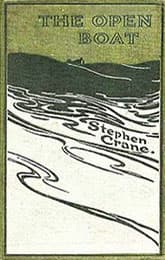The Open Boat
 The Open Boat and Other Tales of Adventure, first American edition, 1898
The Open Boat and Other Tales of Adventure, first American edition, 1898First publication
1897
Literature form
Story
Genres
Literary, adventure
Writing language
English
Author's country
United States
Length
Approx. 9,500 words
Four men and the sea
You could set Stephen Crane's "The Open Boat" and Ernest Hemingway's The Old Man and the Sea as, respectively, the start and culmination of a certain kind of American storytelling. Call it psychological realism, or hard-bitten modernism, or something else, but there's a real line of development here. It's not coincidental that Hemingway was a great admirer of Crane's work.
"The Open Boat" is still a terrific read. A "classic" you don't have to force yourself through. The plot is simple: four men are in a dinghy after their boat sank off the coast of Florida (a situation Crane himself had experienced).
The men are identified only by their occupations: the cook, the oiler, the correspondent and the injured captain. They are trying to row ashore through overwhelming waves that threaten to swamp them, but instead they get forced further out. A shark circles.
As in Hemingway's tale, great hopes are raised only to be crushed by indifferent nature. And, also, the real story is the minds of the boat's occupants.
It's interesting to note the differences though. Crane in 1898 is, as might be expected, less sophisticated in his psychological approach. We are told directly the states of the men's minds—their desperation, their angers, their railing against fate, their fatigue—rather than infer this from their random thoughts, as we do with Hemingway's fisherman five decades later. The correspondent, the "Open Boat" character whose point of view we share, is obviously a stand-in for the author, while in The Old Man and the Sea the author is never there; once on the sea, only the old man exists with the elements.
In Crane's story, everything focuses on the matter at hand, the fight against the elements. All we're told directly about the characters is their professions, not even their names.
In Hemingway's we get the entire man, his most profound thoughts about life as well as his most trivial and practical concerns, everything that passes through his mind. True, it's a novella, while "Open Boat" is a short story and therefore must be more focused. But even so, this illustrates a development in the modern story: a growing use of miscellaneous thoughts and events to create an impressionistic canvas. Hemingway needs the space to let his character and environment breathe, take shape, while Crane has us holding our breath, never straying from the central crisis, until the last line.
Both approaches are valid, of course. They are on the same spectrum of the developing short story—American form. Being so immersed in modernist and post-modern writing these days, a reader may find refreshing to occasionally read the more direct style from the early days of this movement.
"The Open Boat" is found in many anthologies, but your best choice may be The Open Boat and Other Stories, which also includes Crane's neglected first short novel, Maggie: A Girl of the Streets and two other great Crane stories, "The Blue Hotel" and "The Bride Comes to Yellow Sky".
— Eric

